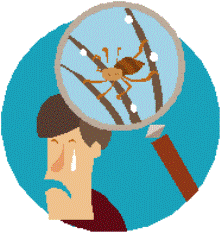By Deborah Z. Altschuler, President, National Pediculosis Association
 Many diseases affect our child population today, but few are as communicable and widespread as head lice and involve the repeated direct exposure of young children to pesticides. This blog discusses head lice treatment alternatives.
Many diseases affect our child population today, but few are as communicable and widespread as head lice and involve the repeated direct exposure of young children to pesticides. This blog discusses head lice treatment alternatives.
The National Pediculosis Association (NP A), the only non-profit health education agency established to protect children from potentially harmful pesticidal treatments for head lice and scabies, reports that head lice appear to be resistant to commercially available chemical treatments, including the prescription chemical lindane and the over-the-counter pediculicides.
Pesticides such as lindane have been linked to neurological complications such as seizures, attention deficits, significant developmental delays and even death.
The $100 million a year pediculicide industry is a growing one. Brisk sales of lice treatments spell good news for profit margins but bad news for the public’s health. This is especially true when too many products are repeat purchases and therefore represent repeated chemical exposures for a family dealing with treatment failure, or lack of success in extinguishing the lice.
There are many elements that can play a role in treatment failure. While there is more than sufficient reason to seriously consider insect resistance, we must also acknowledge other possible contributing factors such as non-compliance with nit removal, failure to follow product treatment instructions, and false hope generated by product marketing.
While treatment failures have been reported for all of the commercially available pediculicides, the majority of reports have involved the two largest selling products, NIX and RID. For the past six months, the NPA has been averaging 50 calls a day from parents and health professionals reporting product treatment failure.
Frustrated parents have responded to persistent infestations by using treatment products repeatedly, or by resorting to dangerous alternatives such as lindane (commonly known as Kwell), lice sprays, dog flea and tick shampoo and kerosene. Until the treatment failure crisis is addressed by the scientific and medical community as well as product manufacturers, the NPA is focusing its efforts on getting parents “Back-to-Basics.”
“Back-to-Basics” means revisiting a philosophy of friends and neighbors helping each other, parents supporting the school with volunteerism and backing it up with similar efforts at home. This will prevent the stigma of head lice infestation from dividing friends and damaging families.
Outbreaks of lice can bring schools to their knees. A crisis intervention approach to head lice outbreaks is an impediment to education. Instead head lice prevention and education should be part of every school health program.
The NPA does not claim to have all the answers to the serious question of possible lice resistance. However, in the meantime, we are offering the following suggestions for those who use a lice treatment product and experience treatment failure:
Discontinue use at the earliest sign of treatment failure. Do not continue using the same or other products in the hope of killing the lice. Remember that lice treatment products are pesticides. Repeated use, or following one brand with another can pose a variety of serious health risks as adverse reaction reports to our national registry have indicated.
Never resort to dangerous remedies such as lindane, kerosene, or pet shampoos.
Never use a lice spray. Lice sprays are pesticides marketed for use on children’s bedding, cars, rugs, garments, and furniture. Vacuuming is the safe and effective alternative to spraying. Parents need not exhaust their physical and emotional selves by obsessive housecleaning and “bagging”. Head lice are human parasites and will not survive without human blood. Parents should save their energies for that which pays the most benefit: manual removal of both lice and eggs from the infested individuals.
Manual removal is crucial when pediculicides have failed. Use safety scissors to snip out individual hairs with attached nits. Nit combing tools that don’t always work for nit removal, can work to comb out critters. Since head lice move quickly throughout the head, it may be helpful to have at least two people checking an infested person at the same time.
Besides the nit combing tool to help remove live lice, other methods of manual removal include using tweezers, fingernails and double-sided scotch tape. Manual removal is tedious, but it is the only alternative available at this time and serves as a stopgap public health measure to prevent inadvertent chemical poisonings. We do not consider this method to be the total solution to the treatment failure crisis.
Continue to check your children often. Screening for lice and nits and early detection is the best way to manage an infestation. Make checking for lice and nits part of routine hygiene.
For more go to www.headlice.org
